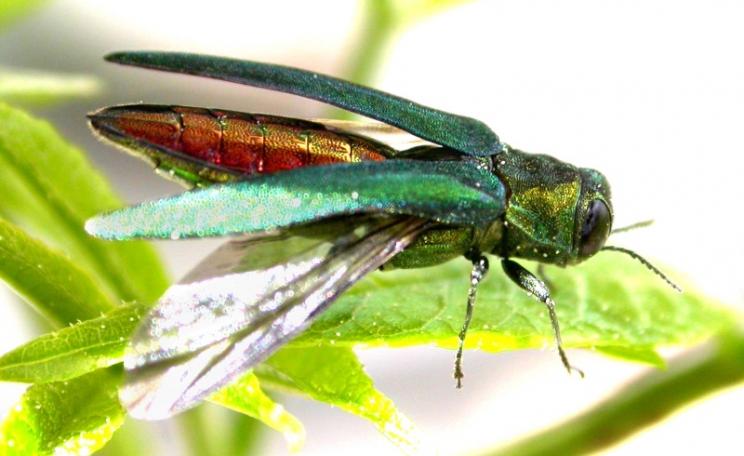The sounds are coming from the ground and the tree-tops, melding across the whole 30-metre diameter sonosphere and always accompanied by the resident ensemble of chaffinches, wrens and chiffchaffs.
You approach Living Symphonies along several hundred metres of forest track.
At each turn the human sounds of the car park, cafe and play area recede and the songs of goldcrest and siskin, and of wind in trees, take over. You keep following the signs, and gradually become aware of a new set of sounds.
Bell-like harmonics, muffled by the forest at first, become clearer as you approach, and eventually much finer sonic detail is revealed as you find yourself on the edge, and then in the midst, of a concert hall whose architecture is that of the trees themselves.
This is Living Symphonies, a 3-dimensional soundscape within a landscape. It is the brainchild of artist / composer duo Daniel Jones and James Bulley. After nearly two years in the making, it is touring Forestry Commission sites during the summer; I went along to its first venue, Thetford Forest, in May.
Living Symphonies from Jones/Bulley on Vimeo.
The path wound down into a natural amphitheatre populated by tall trees. As you descend into the amphitheatre you realise you are surrounded by a gamelan - like ensemble of hidden speakers playing what at times sound like oriental gongs and prayer bowls, at others more conventional strings and flutes.
The sounds are coming from the ground and the tree-tops, melding across the whole 30-metre diameter sonosphere and always accompanied by the resident ensemble of chaffinches, wrens and chiffchaffs.
From time to time the mood changes, sometimes sounding more orchestral, darker, sometimes lighter and more rhythmic. What governs these changes, and the whole symphonic experience from its overall architecture to its finest motivic detail, is a sophisticated software model of the very ecosystem in which the performance takes place.
Ecosystem model
I found Daniel Jones in the cramped trailer that houses the Living Symphonies' nerve-centre. A milky way of blinking lights emanated from an impressive bank of amplifiers, controlled by a modest-looking laptop.
On the screen was a schematic of the amphitheatre, each tree and speaker mapped. At first, there did not seem to be much going on but then a triangle appeared, moving in a slightly curved line across the screen.
"Ah, there's a buzzard overhead", says Daniel, and shortly afterwards a bee moved a few screen-inches and a wren arrived from somewhere off-screen to the south.
It took me a few seconds to realise that we were not tracking the lives of real creatures - not exactly anyway. We were witnessing digital scenarios constructed from careful observation of the wildlife that inhabits the forest: the species composition, relative abundance and even behaviour patterns.
The sounds are coming from the ground and the tree-tops, melding across the whole 30-metre diameter sonosphere and always accompanied by the resident ensemble of chaffinches, wrens and chiffchaffs.
Real-time weather monitoring, using a portable weather station next to the trailer, is part of the mix of inputs, and governs the activity levels of, say, virtual soil creatures like earthworms.
Each forest location was surveyed in detail to understand what flora and fauna live nearby, with the help of ecologists and wildlife rangers from the Forestry Commission, who studied animal habitats, food sources and movement patterns, building up a metre-by-metre map of the forest.
Each species is depicted by a unique set of musical motifs that portray its changing behaviours, and these are mixed and spatialised in unrepeatable combinations via 24 hidden, weather-proof speakers.
Real Musicians
James Bulley describes this as "generative art" - once the artists have created the sonic material and the computer model, they cede control to nature and circumstance.
"Using real musicians to record fragments of composed material on acoustic instruments helped create an organic feel and maintain authenticity", he explained.
For me, it resulted in a real sense of it being a performance, even though the piece as a whole cannot be perfomed live in any real sense.
But there was enough expression, improvised detail, and idiomatic technique to give a feeling that musicians, composers, audience and nature itself were connecting in real time.
Living Symphonies is commissioned by Forestry Commission England and tours FCE sites in Northamptonshire, Staffordshire and Kent for a week each during June to September.
- Dates and places here - free admission!
- Living Symphonies website.
- Preview video here.
Laurence Rose is the RSPB's North Norfolk Coast manager, and is a composer and writer.
Follow him on Twitter: @Laurence_R_RSPB
James Bulley and Daniel Jones are an artist duo whose collaborative practice explores the boundaries of sound art, music, and process-based composition.
Their work draws on systems and patterns from the world around us as a way of organising sound, creating a reciprocal relationship between the two: using sound as a way to illuminate our understanding of the world, and using natural processes as a way to deepen our approaches to musical composition.







